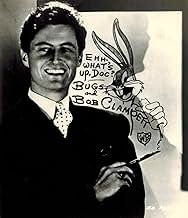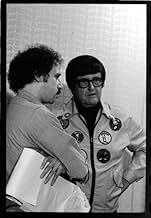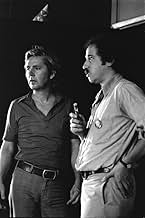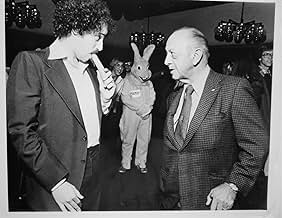Füge eine Handlung in deiner Sprache hinzuLooney Tunes documentary film hosted by Bob Clampett, including nine complete cartoons from the 40s and the artists behind the characters.Looney Tunes documentary film hosted by Bob Clampett, including nine complete cartoons from the 40s and the artists behind the characters.Looney Tunes documentary film hosted by Bob Clampett, including nine complete cartoons from the 40s and the artists behind the characters.
Orson Welles
- Narrator
- (Synchronisation)
Mel Blanc
- Various Characters
- (Synchronisation)
Robert Clampett
- Self
- (as Bob Clampett)
Arthur Q. Bryan
- Elmer Fudd
- (Synchronisation)
- (Nicht genannt)
Empfohlene Bewertungen
This compilation features priceless archival footage from the WB animation artists' working and living conditions, and nine entertaining, timeless cartoon shorts. Although it eventually wears you out a little (I think those cartoons look better if taken in smaller doses), it is a much better choice for family viewing than many, many other films that claim to serve the same purpose. Long live Bugs! (***)
This was the first feature length "Looney Tunes" movie made. The fourth one was actually titled "Bugs Bunny's 3rd Movie", but this is still technically the original. It features various Looney Tunes cartoons which were done in the other movies. I generally don't watch documentaries, but I'll make an exception for this, because it focused on narrative in the Looney Tunes series. Unlike the other films, this one was done with live-action bits between the cartoons. Judging from the title, it's mostly about Bugs Bunny, but does talk about the franchise in general and features about 23 minutes of new material.
The best part might have been hearing how Mel Blanc had to spit out carrots after every take. It is false that he was allergic to them. He just hated them! There's no cartoons after 1949, presumably because that's the year Leon Schlesinger died. Apart from Mel Blanc, he worked on more Looney Tunes cartoons than anyone else in history, even more than Chuck Jones or Friz Freleng. He was the producer and not the director, which is probably why he's not remembered as much. ****
The best part might have been hearing how Mel Blanc had to spit out carrots after every take. It is false that he was allergic to them. He just hated them! There's no cartoons after 1949, presumably because that's the year Leon Schlesinger died. Apart from Mel Blanc, he worked on more Looney Tunes cartoons than anyone else in history, even more than Chuck Jones or Friz Freleng. He was the producer and not the director, which is probably why he's not remembered as much. ****
I'm surprised to read so few comments about Bugs Bunny, Superstar. So I'll chime in. Besides, it'll give me som'in' positive to say. They're all here - not just Bugs. This nine-cartoon compilation also features Elmer Fudd, Tweety, Silvester, Henry-the-Chicken-Hawk, Foghorn Leghorn, Porky, Daffy. It's kind of a "Best of." I thought that it was very, very good. There is some narration by Orson Welles and the difficult-to-pull-off segue from cartoon to cartoon is filled by interesting home-movie-type, black-and-white glimpses of how it was where the comics were created - the people behind the characters - the artists, the musicians, the voice (singular - Mel Blanc). But imagine this: I didn't hear the word "computer" during the entire film! This is one of the few videos that I would actually buy - I could watch it over and over. Must be the kid in me. Speaking of kids, I'll bet there's generations of 'em, the majority of whom have seen Bugs, Elmer, Porky, Daffy, Tweety, Sylvester. But I'll also bet that the majority of CURRENT cartoons are NOT known from generation to generation. Might that be a testament to how deservingly enduring these Looney Toons are?
When I was five, I first saw the documentary "Bugs Bunny Superstar" and my parents made me a tape of it; unfortunately, we accidentally taped over the end. Now that I've seen the whole thing again - and that I'm old enough to understand what it shows - I can accurately comment on it.
It starts with a disembodied voice (actually Orson Welles narrating) showing photographs of the places representing the greatest minds: the Great Wall of China, the Taj Mahal, the Pyramids, the Parthenon, the Coliseum, the Eiffel Tower, the White House (well, not currently), Termite Terrace...wait a minute, Termite Terrace? Yes, Termite Terrace. For the uninformed, it's the back-lot on the Warner Bros. studios where they created the Looney Tunes/Merrie Melodies cartoons. So begins a cinematic trip down Memory Lane.
The movie consists of an interview with animator Bob Clampett explaining how they created Bugs, Daffy, Porky, etc. When I was really young, even though I saw the caricatures of Humphrey Bogart, Peter Lorre and Edward G. Robinson - plus the scenes from "The Jazz Singer" and "It Happened One Night" - I couldn't interpret anything from them, but of course now I can. It was especially neat to hear about the typical days in Termite Terrace; it all sounded really fun! But of course, the best parts are the nine classic cartoons included in the movie to affirm what Clampett says. All released before 1948, they give one a true sense of old-time cinema (especially with Bugs Bunny at the Oscars). As it is, this documentary's 1975 release brings to mind the '50s nostalgia that had swept the country, as displayed by "Happy Days". While the stuff portrayed here is pre-'50s, it still makes one nostalgic for the old times. You're sure to have a real hare-raising time! There's also an interview with Friz Freleng, some footage of Mel Blanc, while Elmer, Sylvester, Tweety, and Foghorn also appear in the cartoons.
One more thing. When MGM released "Bugs Bunny Superstar" on video in 1988, they also released the video collections "BUGS!" (whose cover showed Bugs holding an Oscar), "DAFFY!" (showing Daffy wearing sunglasses), "PORKY!" (showing Porky driving a fancy car), and "ELMER!" (showing Elmer sitting in a director's chair). In keeping with the documentary, they all contained cartoons released before or during 1948 (e.g., "Bugs Bunny Gets the Boid", "The Great Piggy Bank Robbery", "Baby Bottleneck" and "Good Night, Elmer"). I wonder why MGM released them onto video.
It starts with a disembodied voice (actually Orson Welles narrating) showing photographs of the places representing the greatest minds: the Great Wall of China, the Taj Mahal, the Pyramids, the Parthenon, the Coliseum, the Eiffel Tower, the White House (well, not currently), Termite Terrace...wait a minute, Termite Terrace? Yes, Termite Terrace. For the uninformed, it's the back-lot on the Warner Bros. studios where they created the Looney Tunes/Merrie Melodies cartoons. So begins a cinematic trip down Memory Lane.
The movie consists of an interview with animator Bob Clampett explaining how they created Bugs, Daffy, Porky, etc. When I was really young, even though I saw the caricatures of Humphrey Bogart, Peter Lorre and Edward G. Robinson - plus the scenes from "The Jazz Singer" and "It Happened One Night" - I couldn't interpret anything from them, but of course now I can. It was especially neat to hear about the typical days in Termite Terrace; it all sounded really fun! But of course, the best parts are the nine classic cartoons included in the movie to affirm what Clampett says. All released before 1948, they give one a true sense of old-time cinema (especially with Bugs Bunny at the Oscars). As it is, this documentary's 1975 release brings to mind the '50s nostalgia that had swept the country, as displayed by "Happy Days". While the stuff portrayed here is pre-'50s, it still makes one nostalgic for the old times. You're sure to have a real hare-raising time! There's also an interview with Friz Freleng, some footage of Mel Blanc, while Elmer, Sylvester, Tweety, and Foghorn also appear in the cartoons.
One more thing. When MGM released "Bugs Bunny Superstar" on video in 1988, they also released the video collections "BUGS!" (whose cover showed Bugs holding an Oscar), "DAFFY!" (showing Daffy wearing sunglasses), "PORKY!" (showing Porky driving a fancy car), and "ELMER!" (showing Elmer sitting in a director's chair). In keeping with the documentary, they all contained cartoons released before or during 1948 (e.g., "Bugs Bunny Gets the Boid", "The Great Piggy Bank Robbery", "Baby Bottleneck" and "Good Night, Elmer"). I wonder why MGM released them onto video.
This superb compilation, appropriately narrated by another American cultural giant, Orson Welles, features the best of the 1940s Looney Tunes output, not just Bugs, but Sylvester, Tweetie, Daffy, Porky and Foghorn: 'What's Cookin' Doc', 'A Wild Hare', 'A Corny Concerto', 'Rhapsody Rabbit', 'I Saw A Putty Tat', 'Walky Talky Hawky', 'My Favorite Duck', 'Hair Raising Hare' and ''Old Grey Hare' (see my individual reviews).
As a piece of cultural history, this semi-documentary is inadequate - there is no attempt to explain the subversiveness of these irreverent, flippant, violent, beautiful cartoons in the context of Disney-dominating ick-animation and gloomy, propaganda-laden World War Two - to which many of these cartoons tacitly refer, revealing complicated truths other 'real' films couldn't dare, such as the barbaric effect fighting barbarians can have on 'our' side; there is no analysis of the glorious pretention-pricking of both Hollywood and high culture, or Bugs' androgynous proteanism, or how the cartoons retained a level of fresh invention while seemingly locked in repetitive formulae; of the powerful psychoanalytic premisses of each short, in which a wild, elusive, lawless animal stands in for our stifled desires, especially as World War Two gives on to the post-war world of Joe McCarthy and chums.
Rather, the in-between nostalgic bits celebrate harmless anecdote and japery, putting animation on its proper, neutered level. The cartoons themselves triumphantly bely such a project.
As a piece of cultural history, this semi-documentary is inadequate - there is no attempt to explain the subversiveness of these irreverent, flippant, violent, beautiful cartoons in the context of Disney-dominating ick-animation and gloomy, propaganda-laden World War Two - to which many of these cartoons tacitly refer, revealing complicated truths other 'real' films couldn't dare, such as the barbaric effect fighting barbarians can have on 'our' side; there is no analysis of the glorious pretention-pricking of both Hollywood and high culture, or Bugs' androgynous proteanism, or how the cartoons retained a level of fresh invention while seemingly locked in repetitive formulae; of the powerful psychoanalytic premisses of each short, in which a wild, elusive, lawless animal stands in for our stifled desires, especially as World War Two gives on to the post-war world of Joe McCarthy and chums.
Rather, the in-between nostalgic bits celebrate harmless anecdote and japery, putting animation on its proper, neutered level. The cartoons themselves triumphantly bely such a project.
Wusstest du schon
- WissenswertesIncludes the following cartoons in their entirety: What's Cookin' Doc? (1944), Die Hasenfalle (1940), Wunderliche Walzerträume (1943), Tweety macht fette Beute (1948), Da Capo, Bunny (1946), Hühnerauge, sei wachsam (1946), Porky macht Camping (1942), Angsthase Pfeffernase (1946) and Hasenjagd ist angesagt (1944).
- PatzerAbraham Lincoln was born in Kentucky, not Illinois.
- Alternative VersionenOn the 2006 Warner Bros. DVD, a two-part special feature in the box set Looney Tunes Golden Collection: Volume 4, all but two cartoons were replaced by versions created by Turner Entertainment in 1995. The Old Grey Hare used an original a.a.p. print (evidenced by the a.a.p. opening soundtrack) to preserve the ending gag involving the "That's all, Folks" title card, which was lost in the Turner updated version. I Taw a Putty Tat was also restored to the a.a.p. print, as the Turner version contained an edit to remove a blackface gag. Aside from leaving in the edited scene, however, the print on the set is basically the same as the Turner version.
- VerbindungenEdited from Der Jazzsänger (1927)
- SoundtracksChew Turn Me On
Written by Robert Clampett (as Bob Clampett) and Ian Whitcomb
Top-Auswahl
Melde dich zum Bewerten an und greife auf die Watchlist für personalisierte Empfehlungen zu.
Details
Zu dieser Seite beitragen
Bearbeitung vorschlagen oder fehlenden Inhalt hinzufügen









